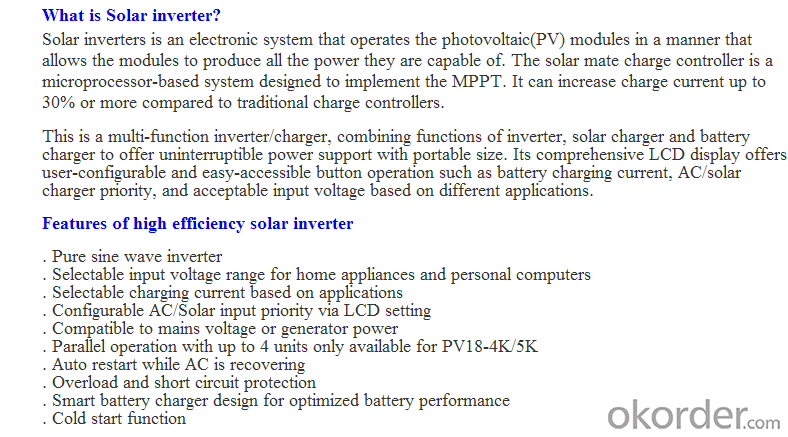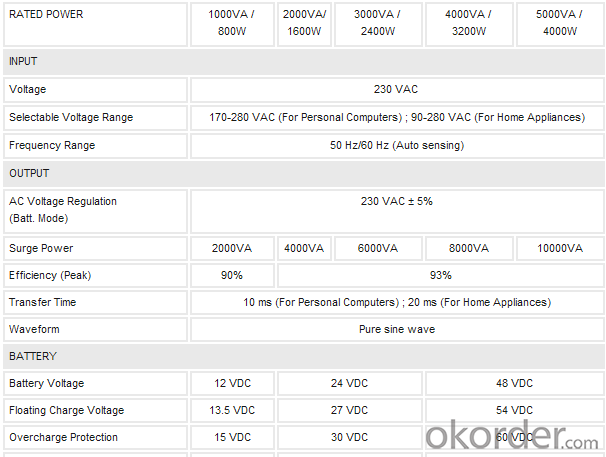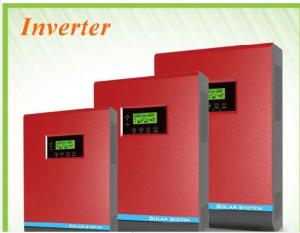On Grid Solar Inverter GS1500-SS
- Loading Port:
- Shanghai
- Payment Terms:
- TT or LC
- Min Order Qty:
- 10 unit
- Supply Capability:
- 100 unit/month
OKorder Service Pledge
OKorder Financial Service
You Might Also Like
Description:
GW1500-SS photovoltaic inverter is suitable for home rooftop photovoltaic system, designed under modern industrial concept. There are three colors for option with fashionable appearance. This model is applicable for the photovoltaic system with open-circuit voltage less than 450V, maximum output power less than 1800W. Its maximum conversion efficiency can reach 97%. First-class harmonic control ability, small size and light weight make it hold a safe lead among similar products.



FAQ:What's your warranty?
Our warranty is 1 year
- Q:Can a solar inverter be used with solar-powered recreational vehicles (RVs)?
- Yes, a solar inverter can be used with solar-powered recreational vehicles (RVs). A solar inverter converts the DC (direct current) energy generated by solar panels into AC (alternating current) energy that can be used to power various appliances and devices in an RV. This allows RV owners to utilize solar energy for their electrical needs while on the road.
- Q:What is the role of a fault detection feature in a solar inverter?
- The role of a fault detection feature in a solar inverter is to monitor and identify any abnormalities or malfunctions in the system. This feature plays a crucial role in ensuring the reliable and efficient operation of the solar inverter. A fault detection feature is designed to constantly monitor the various components and parameters of the solar inverter, including input voltage, output voltage, current levels, temperature, and other critical parameters. It analyzes the data in real-time and compares it with predefined thresholds or expected values. If any parameter deviates from the normal range or exceeds the set limits, the fault detection feature immediately identifies it as a fault or abnormality. The primary purpose of this feature is to protect the solar inverter from potential damage and prevent any possible safety hazards. By promptly detecting faults, it enables the inverter to take appropriate actions to mitigate the issue or to shut down the system if necessary. This helps in avoiding further damage to the inverter or other connected devices. Additionally, the fault detection feature aids in troubleshooting and diagnosing the root cause of the fault. It provides valuable information about the type and location of the fault, facilitating quicker and more accurate repairs or maintenance. This reduces downtime and ensures the optimal performance and longevity of the solar inverter. Furthermore, the fault detection feature plays a vital role in system monitoring and maintenance. It provides valuable data and alerts to the system operator or maintenance personnel, enabling them to proactively address any potential issues. This helps in maximizing the uptime of the solar inverter and minimizing the overall maintenance costs. In summary, the fault detection feature in a solar inverter is responsible for continuously monitoring, identifying, and responding to any faults or abnormalities in the system. It acts as a protective mechanism, ensuring the safe and reliable operation of the inverter, enabling quick troubleshooting, and facilitating efficient maintenance practices.
- Q:Are there any safety considerations when installing a solar inverter?
- Yes, there are several safety considerations when installing a solar inverter. Firstly, it is important to ensure that the installation is done by a qualified professional who has the necessary knowledge and expertise. Additionally, proper grounding and electrical connections should be established to minimize the risk of electric shocks or fires. Adequate ventilation and protection from moisture should also be provided to prevent overheating and damage. Lastly, it is crucial to follow all manufacturer's instructions and local building codes to ensure a safe and compliant installation.
- Q:What is the role of a solar inverter in reactive power compensation?
- The role of a solar inverter in reactive power compensation is to regulate and control the flow of reactive power in a solar power system. Reactive power is the power that oscillates between the source and load due to the presence of inductive or capacitive elements in the system. It does not contribute to the actual work done by the system but is necessary for the operation of certain devices. A solar inverter, specifically designed for reactive power compensation, is capable of measuring the reactive power in the system and adjusting its operation accordingly. It can generate or absorb reactive power as required to maintain a power factor close to unity. Power factor is a measure of how efficiently the electrical energy is being used and a high power factor indicates efficient utilization of electricity. By compensating for reactive power, a solar inverter ensures that the solar power system operates at optimal efficiency. It reduces the burden on the grid by supplying or absorbing reactive power locally instead of relying on the grid for compensation. This not only improves the overall power quality but also reduces the losses in the system. Additionally, it helps to stabilize voltage levels and reduce voltage fluctuations, which can be beneficial for sensitive electrical equipment. In summary, the role of a solar inverter in reactive power compensation is to regulate the flow of reactive power in a solar power system, maintaining a high power factor and improving overall system efficiency. It plays a vital role in ensuring optimal operation of the solar power system and reducing the reliance on the grid for reactive power compensation.
- Q:How do you calculate the payback period for a solar inverter?
- To calculate the payback period for a solar inverter, you need to divide the initial cost of the inverter by the annual savings it generates. The payback period is the amount of time it takes for the cumulative savings to equal the initial cost.
- Q:Can a solar inverter be used in a net metering system?
- Yes, a solar inverter can be used in a net metering system. A solar inverter is an essential component of a net metering system as it converts the direct current (DC) produced by the solar panels into alternating current (AC) that can be used to power homes or businesses. It also allows for any excess electricity generated to be fed back into the grid, earning credits or reducing the electricity bill through the net metering arrangement.
- Q:Can a solar inverter be used with a solar-powered educational system?
- Yes, a solar inverter can be used with a solar-powered educational system. A solar inverter is responsible for converting the direct current (DC) produced by solar panels into alternating current (AC) that can be used to power electrical devices. In the case of a solar-powered educational system, the solar inverter plays a crucial role in converting the DC energy generated by the solar panels to AC energy that can be utilized by the educational equipment, such as computers, projectors, or other electrical devices, thereby enabling the system to function efficiently.
- Q:Can a solar inverter be used for off-grid applications?
- Yes, a solar inverter can be used for off-grid applications. Off-grid systems typically rely on solar panels to generate electricity, and a solar inverter is essential in converting the direct current (DC) generated by the panels into alternating current (AC) which can be used to power various appliances and devices. The inverter also manages the flow of electricity, ensures system stability, and may include features like battery charging and energy storage capabilities, making it suitable for off-grid applications where no grid connection is available.
- Q:Can a solar inverter be used in conjunction with a generator?
- Yes, a solar inverter can be used in conjunction with a generator. In fact, it is a common setup in hybrid systems where the solar panels generate electricity during the day, and the generator provides power during periods of low solar production or high energy demand. The solar inverter converts the DC power from the solar panels and the AC power from the generator into a usable form for the connected appliances and the grid. This combination allows for a more reliable and efficient power supply.
- Q:What is the maximum voltage input for a solar inverter?
- The maximum voltage input for a solar inverter typically depends on the specific model and manufacturer. However, in general, it ranges from around 600 to 1000 volts, with some higher-end models able to handle higher voltages.
1. Manufacturer Overview |
|
|---|---|
| Location | |
| Year Established | |
| Annual Output Value | |
| Main Markets | |
| Company Certifications | |
2. Manufacturer Certificates |
|
|---|---|
| a) Certification Name | |
| Range | |
| Reference | |
| Validity Period | |
3. Manufacturer Capability |
|
|---|---|
| a)Trade Capacity | |
| Nearest Port | |
| Export Percentage | |
| No.of Employees in Trade Department | |
| Language Spoken: | |
| b)Factory Information | |
| Factory Size: | |
| No. of Production Lines | |
| Contract Manufacturing | |
| Product Price Range | |
Send your message to us
On Grid Solar Inverter GS1500-SS
- Loading Port:
- Shanghai
- Payment Terms:
- TT or LC
- Min Order Qty:
- 10 unit
- Supply Capability:
- 100 unit/month
OKorder Service Pledge
OKorder Financial Service
Similar products
New products
Hot products
Hot Searches
Related keywords

































